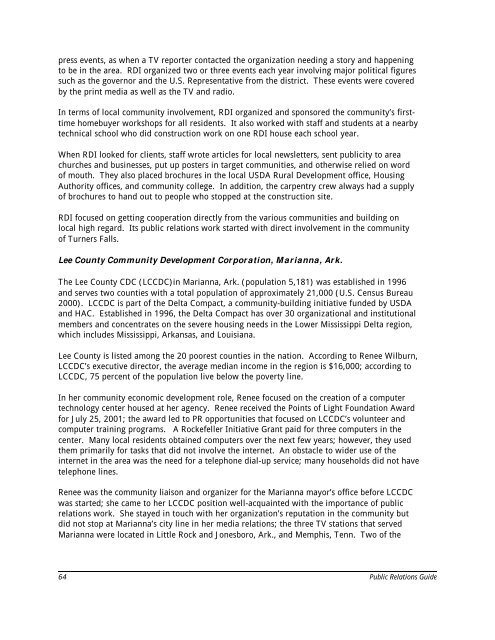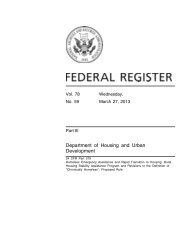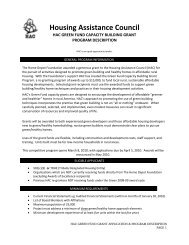Public Relations Guide for Rural Housing Organizations (manual
Public Relations Guide for Rural Housing Organizations (manual
Public Relations Guide for Rural Housing Organizations (manual
Create successful ePaper yourself
Turn your PDF publications into a flip-book with our unique Google optimized e-Paper software.
press events, as when a TV reporter contacted the organization needing a story and happeningto be in the area. RDI organized two or three events each year involving major political figuressuch as the governor and the U.S. Representative from the district. These events were coveredby the print media as well as the TV and radio.In terms of local community involvement, RDI organized and sponsored the community’s firsttimehomebuyer workshops <strong>for</strong> all residents. It also worked with staff and students at a nearbytechnical school who did construction work on one RDI house each school year.When RDI looked <strong>for</strong> clients, staff wrote articles <strong>for</strong> local newsletters, sent publicity to areachurches and businesses, put up posters in target communities, and otherwise relied on wordof mouth. They also placed brochures in the local USDA <strong>Rural</strong> Development office, <strong>Housing</strong>Authority offices, and community college. In addition, the carpentry crew always had a supplyof brochures to hand out to people who stopped at the construction site.RDI focused on getting cooperation directly from the various communities and building onlocal high regard. Its public relations work started with direct involvement in the communityof Turners Falls.Lee County Community Development Corporation, Marianna, Ark.The Lee County CDC (LCCDC)in Marianna, Ark. (population 5,181) was established in 1996and serves two counties with a total population of approximately 21,000 (U.S. Census Bureau2000). LCCDC is part of the Delta Compact, a community-building initiative funded by USDAand HAC. Established in 1996, the Delta Compact has over 30 organizational and institutionalmembers and concentrates on the severe housing needs in the Lower Mississippi Delta region,which includes Mississippi, Arkansas, and Louisiana.Lee County is listed among the 20 poorest counties in the nation. According to Renee Wilburn,LCCDC’s executive director, the average median income in the region is $16,000; according toLCCDC, 75 percent of the population live below the poverty line.In her community economic development role, Renee focused on the creation of a computertechnology center housed at her agency. Renee received the Points of Light Foundation Award<strong>for</strong> July 25, 2001; the award led to PR opportunities that focused on LCCDC’s volunteer andcomputer training programs. A Rockefeller Initiative Grant paid <strong>for</strong> three computers in thecenter. Many local residents obtained computers over the next few years; however, they usedthem primarily <strong>for</strong> tasks that did not involve the internet. An obstacle to wider use of theinternet in the area was the need <strong>for</strong> a telephone dial-up service; many households did not havetelephone lines.Renee was the community liaison and organizer <strong>for</strong> the Marianna mayor’s office be<strong>for</strong>e LCCDCwas started; she came to her LCCDC position well-acquainted with the importance of publicrelations work. She stayed in touch with her organization’s reputation in the community butdid not stop at Marianna’s city line in her media relations; the three TV stations that servedMarianna were located in Little Rock and Jonesboro, Ark., and Memphis, Tenn. Two of the64 <strong>Public</strong> <strong>Relations</strong> <strong>Guide</strong>









